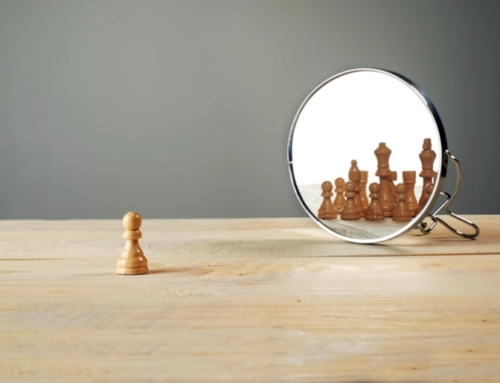Have you ever had a friend or family member confide very sensitive information to you? As clinicians we have patients tell us – and we’re not shy about asking – all types of pertinent personal information. But in our private lives it’s different when someone confides something to us.
If you’ve been the recipient of this type of sharing, I’m pretty sure you acquitted yourself well: You listened, conveyed support verbally and non-verbally, and, perhaps, promised to help. You may have felt a sense of gratitude to be trusted enough to be the bearer of this disclosure. You likely felt compassion for and a new-found closeness to the teller. After all, they likely divulged information that was hard to divulge, something embarrassing or shameful.
Now, let me shift directions in this thought experiment. Imagine now that that sharer of sensitive information is none other than you and you are sharing this sensitive information with – wait for it – none other than yourself!
It may seem counterintuitive – silly, even – to think that we keep secrets from ourselves. But at some level at least, we do. And this standing apart from parts of ourselves – from our guilt, shame, desires, fears, frustrations, rages, and hates – can lead to a life that’s shadow-like, two-dimensional, and less-than-vital. It’s so easy to continue to follow the tracks that our parents laid out for us, living to their expectations; or living to expectations we set for ourselves years or decades ago; or perhaps, settling for something because we fear something greater. Or denying desires and fears to ourselves we are dimly aware of but push away when they arise.
I’m not advocating for getting in touch with our hidden aspects in order to act out destructive and self-destructive urges. I’m advocating for self-understanding and self-acceptance. In fact, I think that denial, suppression, and repression is more likely to give way one day and lead to a major rupture in one’s relationships, self-concept, and future possibilities.
Thus, the concept of the two chairs, the brainchild of physician and therapist Fritz Perls, developer of Gestalt therapy, especially popular in the 1960s. Although its direct popularity has fallen in the intervening decades, partly because Fritz Perls was a consummate showman and his death took away the therapy’s main evangelist, Gestalt therapy’s concepts and interventions have been incorporated into newer therapies and life coaching and self-help approaches. Gestalt therapy focused on self-knowledge, self-acceptance, personal responsibility, increased awareness, and effective change. It is one of this therapies very simple and effective techniques I’d like to share with you today.
It’s called the technique of the Two Chairs (also known as the empty chair), a technique that became so popular that it turned into a cliché and was ultimately downplayed by Dr. Perls and other Gestaltists. But there is a good reason for its popularity: it can be transformational.
In short, Two Chairs requires the person (any person who wants to use this technique) to sit in a chair opposite an empty chair. In the empty chair the person imagines another person, perhaps someone they’re in a relationship with that is causing problems. They imagine they are speaking to the imagined person and working out their conflicted feelings towards that person and approaches to communicating with that person.
And, more pertinent to today’s post, the person can imagine themselves sitting in that empty chair. As a further tweak, they can imagine only certain aspects of themselves and speak to those particular aspects. Those aspects can be an emotion, a desire, a self-concept, a type of self-destructive behavior they engage in, a past traumatic event, a past event that causes shame or guilt, or some secret they’ve been keeping from themselves. The empty chair also affords the opportunity for the person to move between the two chairs, dialoging with themselves.
I’ve tried this on myself and found it to be, at the start, extremely embarrassing, even though I’m the only one in the room, but also extremely freeing, leading to self-discovery and self-acceptance. Now, I use it more frequently to identify what’s truly important to me to focus on. At my age I feel my time on earth is dwindling and I need to use it wisely. My problem is I am a “Jack of all trades” – my mother named me aptly – and I like to pursue too many “bright shiny objects.”
In this technique I pretend that I am sitting in the chair across from me – I try to picture my imagined self in as much detail as I can muster – and acting as a life coach to myself, helping the imagined Jack across from me identify what is important, what is getting in the way, and the steps forward. Most of the time now I do this in my mind, partly because it is less embarrassing but also because I’ve done it enough for real, with a real empty chair and speaking aloud, that I have now internalized the experience.
So how can you make use of this technique? Well, just like I do; using it to discern what is important to me from what is unimportant. Perhaps at times you act out angrily and then are embarrassed by it or damage relationships by it. You could talk to your angry self; have the angry self speak out the sources of their anger.
My final thought: Can you show the same concern, care, compassion, and understanding towards yourself as you do toward that friend or family member who confides their deepest secrets to you?
There’s only one way to find out.
Dr. Jack
Language Brief
“He who knows others is wise; he who knows himself is enlightened.” ― Lao Tsu
“Friendship with oneself is all important, because without it one cannot be friends with anyone else in the world.” ― Eleanor Roosevelt
“I am larger, better than I thought; I did not know I held so much goodness. All seems beautiful to me. Whoever denies me, it shall not trouble me; whoever accepts me, he or she shall be blessed, and shall bless me.” ― Walt Whitman, Leaves of Grass
“I embrace my shadow self. Shadows give depth and dimension to my life. I believe in embracing my duality, in learning to let darkness and light, peacefully co-exist, as illumination.” ― Jaeda DeWalt







Leave A Comment